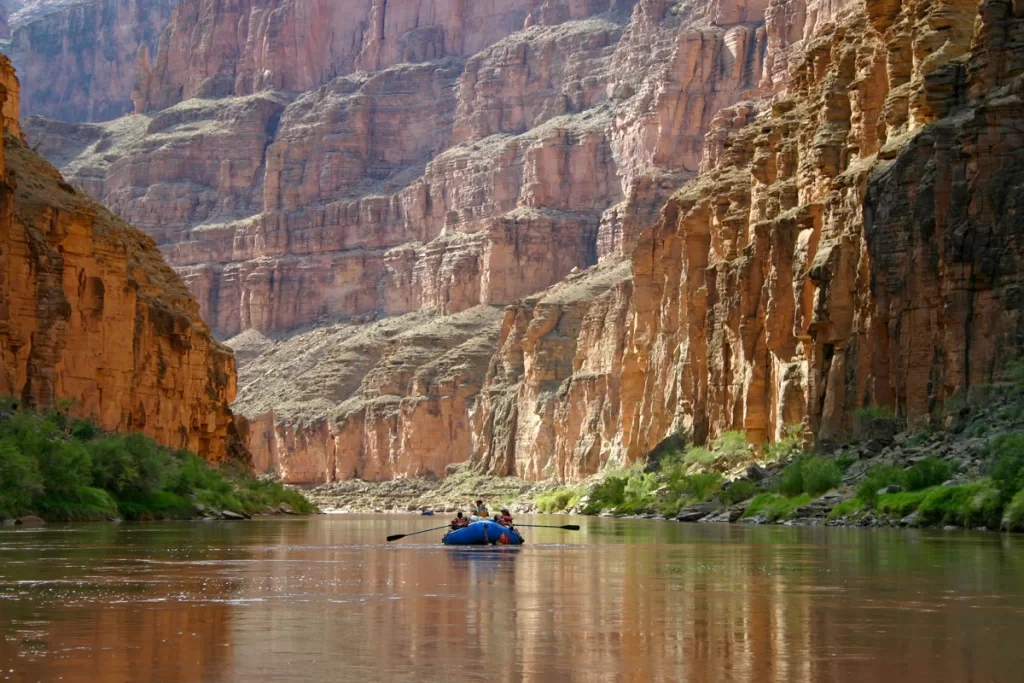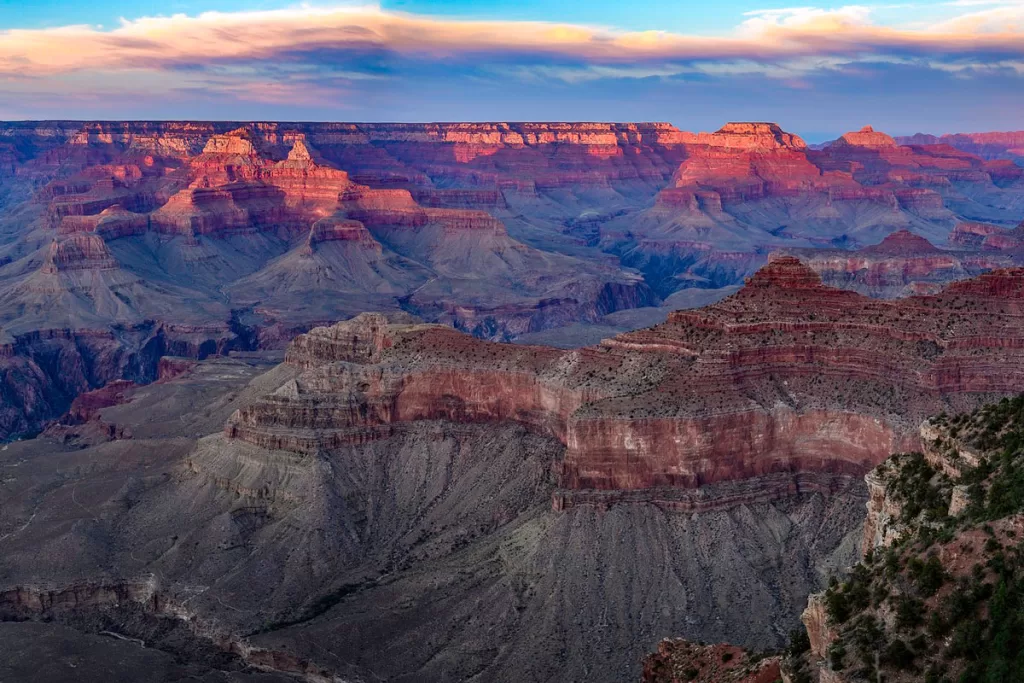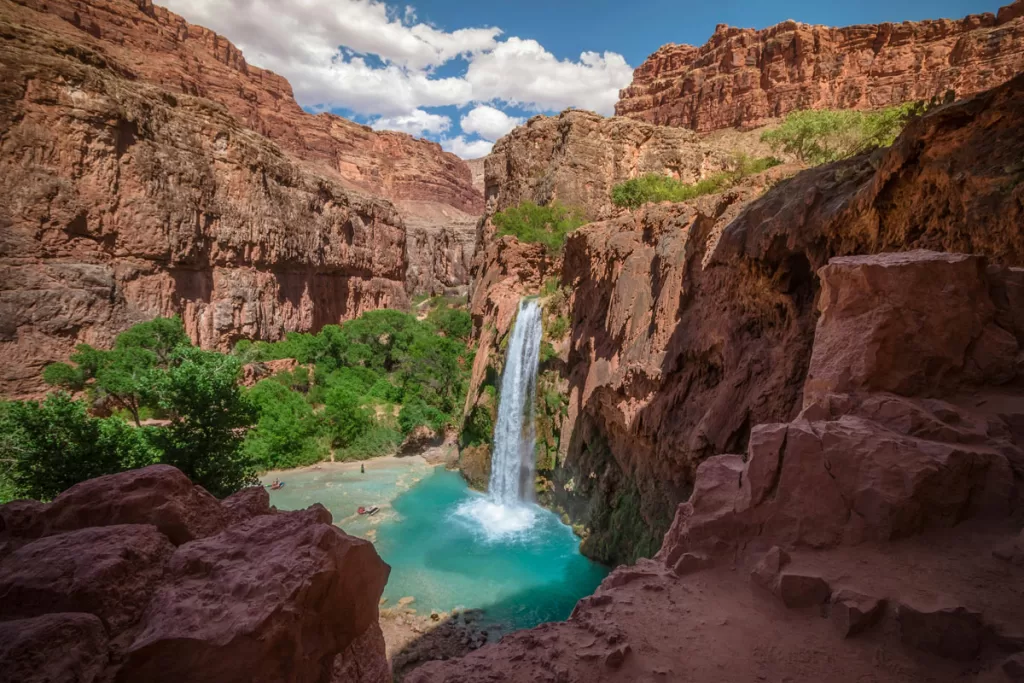As one of the seven natural wonders of the world and one of America’s most famous national parks, there’s no shortage of things to do in the Grand Canyon.
Whether hiking or biking, river rafting, mule riding, or simply soaking up the vastness of it all, this guide highlights all the top things to do in Grand Canyon National Park.
Note: the entire North Rim is closed for the remainder of the 2025 season, due to the Dragon Bravo wildfire. The South Kaibab Trail, Phantom Ranch, and North Kaibab Trail are also closed until further notice. Check current park conditions ahead of your trip, for the most up-to-date information.
Jump to:
- Go for a Hike
- Marvel at One of the Iconic Overlooks
- Raft the Colorado River
- Savor a Dazzling Sunset
- Go for a Scenic Drive
- Take a Traditional Mule Ride
- Bike the South Rim
- Discover Native American Culture and Traditions
- Face Your Fears on the (Glass Floored) Skywalk
- Visit the Most Remote Village in the Continental U.S.
Go for a Hike

The Grand Canyon has numerous hiking options, ranging from short half-mile strolls to blistering 15-mile day hikes.
Most trails depart from a few main trailheads, the most popular being either South Kaibab or Bright Angel Trailheads.
From here, footpaths crisscross and snake down the canyon walls. Due to the natural layout of a canyon, with trails always facing the same direction, the views don’t have as much variety as other national parks. But they still present jaw-dropping panoramas, nonetheless.
You can read our more in-depth summary of hiking in the Grand Canyon here.
Raft the Colorado River

Rafting the Colorado River is a top highlight for thrill-seekers. Options range from half-day outings in gentle currents, to multi-day trips through raging whitewater.
Note that the stretch that winds through the heart of Grand Canyon National Park requires a multi-day trip to reach.
Most 1-day outings launch from Lees Ferry, still within the Grand Canyon but approximately a 2-hour drive from the main visitor center. Don’t let the distance dissuade you, though. It’s still a fascinating adventure, passing through the famous Horseshoe Bend and walls carved with ancient petroglyphs.
You can learn more about Grand Canyon rafting options here, and also read our guide to paddle boarding or kayaking Horseshoe Bend and Marble Canyon here.
Marvel at One of the Iconic Overlooks

There are few things more awe-inspiring than witnessing the vastness of this geological marvel, 2 billion years in the making. Many of the vantage points have views that stretch for up to 40 miles, with otherworldly plateaus of rust, ochre, and vermillion-hued rock.
A few of the park’s top viewpoints include Mather Point and Yavapai Point. Both are located close to the Grand Canyon Visitor Center and easily accessible by paved path.
If you want to go a bit farther afield, either Moran Point (to the east) or Hopi Point (to the west) provide stunning vistas.
Savor a Dazzling Sunset

This is one of our favorite things to do in the Grand Canyon. Each of the overlooks detailed above hit different during sunset, when the setting rays illuminate the canyon walls in dreamy pastel tones. The resulting panoramas are elevated even beyond what you see during regular daylight.
Grab some snacks and drinks, lay down a blanket, and enjoy the magical show that the setting sun puts on each evening. Our personal favorite sunset spots are Yavapai Point and Hopi Point, although you can’t go wrong at any of the overlooks.
Go for a Scenic Drive

There are multiple scenic drives you can enjoy along the South Rim. Each provide the opportunity to see unique vantage points, without much effort.
Our personal favorite drive is the 23-mile (each way) Desert View. It starts at the Grand Canyon Visitor Center before taking you out to the park’s east entrance, which borders Navajo Nation land.
Along the way, you’ll pass such spectacular overlooks as Grandview Point, the Colorado River’s “big bend” at Navajo Point, and Desert Watchtower, built in the 1930s to resemble a traditional Pueblo tower.
Take a Traditional Mule Ride

There are few images more iconic to the Grand Canyon than the sure-footed mule, picking its way down canyon walls. Mules have been ferrying visitors and supplies throughout the canyon for nearly 150 years, and they still remain a memorable way to experience the park.
Mule rides are offered year-round along the South Rim via Xanterra, and also provide a unique opportunity to explore the sparsely-visited North Rim during the summer months (Canyon Rides is the North Rim outfitter).
You can choose either a 2-hour, 7-hour, or overnight trip (which includes a stay at Phantom Ranch). Reservations can be booked 15 months in advance, and fill up quickly!
Bike the South Rim

Did you know the South Rim has nearly 13 miles of roads and trails to explore via bicycle?
Both traditional bikes and e-bikes are permitted on all roads (both paved and unpaved). You can also utilize the park’s free shuttle buses, by biking one way and catching a ride back.
Both bike rentals and guided tours are also available via Bike Grand Canyon.
You can learn more about biking in the Grand Canyon here.
Discover Native American Culture and Traditions

Native Americans have inhabited the region for 4,000 years (although signs of human habitation date back an incredible 10,000 years). The park has numerous opportunities to learn about these traditional land stewards, with immersive exhibits and living history for all ages.
A few of our favorites include:
- Hopi House: situated by Verkamp’s Visitor Center, this structure was built in the early 1900s to resemble the traditional 10,000-year-old pueblos found throughout the region. Today, it serves as a living museum, with a gift shop selling local Native American crafts.
- Desert Watchtower: cultural demonstrations rotate each month amongst the 11 tribes affiliated with the Grand Canyon. You’ll be able to watch tribal members craft everything from pottery to silver, using traditional methods. You can view the monthly calendar here.
- Grand Canyon Visitor Center: at the top of every hour, the movie theater at the main visitor center plays “We Are Grand Canyon”, an uplifting film highlighting the 11 tribal communities who have called the park home for millennia. Admission is free, and with a short 24-minute run time, it’s well-suited for all ages.
Face Your Fears On the (Glass Floored) Skywalk

While it’s technically outside the national park grounds, the Skywalk still provides dizzying views of the Grand Canyon.
Situated on the neighboring Hualapai Reservation, this engineering marvel is a horseshoe-shaped glass promontory, jutting out over the Colorado River 3,600 feet below.
It’s a unique vantage point, for those who don’t have a fear of heights! You can get tickets here.
Visit the Most Remote Village in the Continental U.S.

Sitting at the base of the Grand Canyon (over 3,000 feet below the canyon rim) and only accessible by pack mule or helicopter, Supai Village is deemed the most remote village in the lower 48 states.
However, thousands of tourists make the trek each week (traversing the 16 miles roundtrip, either on foot or via mule). Besides the novelty of its remote location, it is also the gateway to Havasu Canyon and the iconic Havasu Falls.
To get to Supai Village, you’ll need to obtain a permit to Havasu Falls, and one overnight stay is required. The permit comes with your reservation to stay at either the lodge or campsite. Reservations typically open at the beginning of February, and can be obtained here.
For everything you need to know about visiting Supai Village, check out the Visit Arizona page. And don’t forget to mail a postcard from their post office, while you’re there – it comes with a special “mule train mail” stamp!
Have more time to explore the Grand Canyon? Check out our guides to the top 10 hikes and how to paddleboard or kayak Horseshoe Bend and Marble Canyon.
